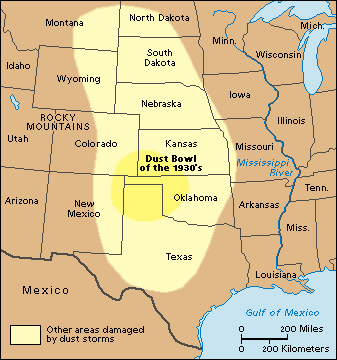Dust Bowl refers to an area in the United States that was devastated by extreme drought, soil erosion, and economic depression during the 1930’s. The worst conditions struck about 50 million acres (20 million hectares), mainly in Colorado, Kansas, New Mexico, Oklahoma, and Texas.

Prior to the 1930’s, decades of commercial agriculture stripped the Great Plains region of native vegetation. Historians place some of the blame on “suitcase farmers”—that is, people who lived far from their farms and only visited during sowing and harvesting time, often leaving most of the work to hired laborers. Many farmers pushed water resources to the limits. They also grew wheat, which did not adequately protect the ground against high winds. Likewise, ranchers often allowed their livestock herds to overgraze, leaving the topsoil of these dry lands exhausted.
Dust storms had struck the Great Plains before, but they were never as large and destructive as those of the 1930’s. Most of the storms came during the spring. About 40 big storms swept through the Dust Bowl in 1935, with dust often reducing visibility to less than a mile (1.6 kilometers). The most destructive storms, often called “black blizzards,” carried tons of soil all the way to the East Coast. They caused great fear among residents, prompting predictions that the end of the world was at hand. The filthy air damaged people’s lungs and caused an illness known as “dust pneumonia.” Piles of dirt had to be shoveled out of houses and away from barn doors. Cars and tractors were ruined.
Loading the player...Dust storm
Many Dust Bowl residents felt defeated by the dust storms and the poor economic conditions. A majority persisted, however, and gained the nickname “stickers.” Others left for new opportunities on the West Coast, where the poverty-stricken migrants from Oklahoma and other Midwestern states became known as “Okies.” The Grapes of Wrath (1939) by John Steinbeck describes the unhappy plight many of these migrants faced. So, too, did the songs of Woody Guthrie, who recorded the album Dust Bowl Ballads (1940).
The federal government developed programs to aid Dust Bowl residents. The Soil Conservation Service, for instance, taught special methods of farming—such as contour plowing, limited tillage, and terracing—to reduce erosion and protect the soil. The Civilian Conservation Corps started “shelterbelt” projects to break the force of the winds. Trees were planted in small groves from Childress, Texas, to the Canadian border.
Residents learned hard lessons while surviving the Dust Bowl. Once rainfall returned to sufficient levels, however, many farmers abandoned conservation. Some began depleting underground aquifers—layers of earth or rock that contain water—with modern irrigation systems. During droughts in the 1950’s and the 1970’s, dust storms again damaged the Dust Bowl region.
